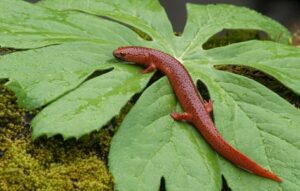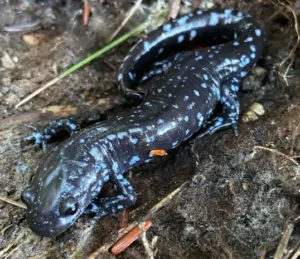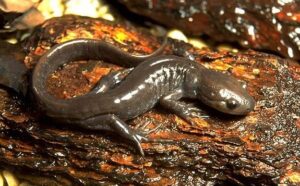Ontario is full of quiet, shaded places where salamanders thrive. You might not see them often, but these slippery, soft-skinned amphibians live hidden lives under damp logs, in mossy forests, and near cool, clean streams. Even though they move slowly and try to avoid attention, some salamanders in Ontario come with a surprising trait, poison.
Yes, some salamanders in Ontario produce mild poisons through their skin to help protect themselves from predators. These skin secretions are not dangerous to people, but they can cause irritation or numbness if they come into contact with eyes or are accidentally swallowed.
What Makes a Salamander “Poisonous”?
In nature, the word “poisonous” means that an animal carries toxins that can cause harm if touched or eaten. This is different from “venomous,” which means the animal delivers its toxins through a bite or sting.
Salamanders are not venomous. They don’t bite or sting. Instead, some species produce toxins on their skin. These poisons serve as a warning to anything thinking about eating them.
If a predator bites into a toxic salamander, it may get a mouthful of bitter, irritating chemicals that make it think twice next time.
For humans, this usually means that touching a salamander is safe as long as you wash your hands afterward. The poison only becomes a problem if it enters the eyes, mouth, or broken skin.
Salamanders Found in Ontario
Ontario is home to about a dozen species of salamanders. Each one lives a quiet life, hidden away in forests, wetlands, or near freshwater streams. Some are more common than others, but all of them are adapted to Ontario’s cool, moist environments.
Here are a few of the species you might encounter:
- Eastern Red-backed Salamander (Plethodon cinereus) – Small and slender with a red or gray stripe down its back
- Spotted Salamander (Ambystoma maculatum) – Glossy black or brown with bright yellow or orange spots
- Blue-spotted Salamander (Ambystoma laterale) – Dark-colored with speckles of electric blue
- Jefferson Salamander (Ambystoma jeffersonianum) – Rare and more muted in color
- Eastern Newt (Notophthalmus viridescens) – Known for its bright orange juvenile form
- Northern Dusky Salamander (Desmognathus fuscus) – A stream-dwelling species that’s easy to miss
Not all of these salamanders are poisonous, but some carry mild toxins in their skin that help them survive.
Which Salamanders in Ontario Are Poisonous?
While many Ontario salamanders rely on hiding or camouflage to avoid danger, a few have developed skin secretions that act as chemical shields.
Let’s look at the most notable ones.
1. Eastern Newt (Notophthalmus viridescens)
This species has a juvenile stage called the “red eft,” which is bright orange and walks on land. The red eft is hard to miss, and its color is more than just decoration, it’s a warning.

Red efts produce tetrodotoxin, a strong poison also found in pufferfish. It affects the nervous system and makes the salamander unappetizing to birds, snakes, and mammals. If a predator eats one, it may experience numbness, drooling, or worse.
For people, touching a red eft isn’t dangerous unless the toxin gets into the eyes or mouth. Still, it’s best to avoid handling them without rinsing your hands afterward.
2. Spotted Salamander (Ambystoma maculatum)
The spotted salamander is common in Ontario’s forests and wetlands. It lives most of its life underground or under cover, coming out mostly at night.

This salamander produces mild skin secretions that taste bad to predators. These secretions come from glands on its back and tail and serve to discourage curious animals.
The toxins are not harmful to people but may cause slight skin irritation in rare cases. It’s still smart to avoid touching your face after handling one.
3. Red Salamander (Pseudotriton ruber)
Although mostly found in the U.S., the red salamander may appear in southern Ontario. It is a deep reddish-orange color with black spots and prefers cool, clean streams.

This salamander also produces irritating skin toxins. The effects on predators are similar to those from the spotted salamander, a bad taste that warns them away from future encounters.
4. Blue-spotted Salamander (Ambystoma laterale)
This small salamander is often found under damp logs in forests. It doesn’t have strong toxins, but it does produce a bitter skin secretion that makes it unappealing to would-be predators.

For humans, this toxin is harmless, but repeated handling can stress the animal and cause skin irritation in sensitive people.
5. Eastern Tiger Salamander (Ambystoma tigrinum)
This large, burrowing salamander has bold yellow or olive blotches on a dark body, giving it a striped appearance. It prefers forests, grasslands, and wetlands, but spends much of its time hidden underground.

The eastern tiger salamander produces a sticky skin secretion when disturbed. This white fluid is released from glands along its back and tail and has a strong, unpleasant taste.
Predators like raccoons, snakes, or birds may try to bite it once but are unlikely to try again. The secretion irritates the mouth and eyes and makes the salamander difficult to swallow.
For humans, the toxin is not dangerous. However, it can cause mild skin or eye irritation if handled carelessly. As with other salamanders, washing hands after contact is a good idea.
How Salamander Toxins Work
Salamander poisons are not injected. Instead, the toxins are passively released through the skin. When a salamander feels threatened, its skin glands begin to produce a slippery coating that contains these chemicals.
These toxins serve several purposes:
- They taste bitter and unpleasant to predators
- They can irritate a predator’s mouth or throat
- They sometimes cause minor numbness or tingling
- In some cases, they are powerful enough to affect nerve function
The goal is not to harm but to teach predators to avoid salamanders in the future.
Are Ontario Salamanders Dangerous to People?
No. For the most part, salamanders in Ontario are safe to observe and handle carefully. Their poisons are mild and rarely affect humans, but there are still a few precautions to keep in mind.
Here are some basic safety tips:
- Wash your hands with clean water after touching any salamander
- Don’t touch your eyes, mouth, or nose after handling one
- Avoid letting young children or pets handle salamanders without supervision
Most reactions in humans involve slight tingling or irritation. These go away quickly with no lasting effects.
How About Pets?
While people can usually handle salamanders without trouble, pets are more sensitive to their toxins. Dogs and cats may try to lick or chew on salamanders they find outside. This can lead to signs of poisoning such as:
- Vomiting or drooling
- Trembling or shaking
- Weakness or confusion
- Loss of coordination
If your pet shows any of these signs after contact with a salamander, contact a veterinarian. Even mild toxins can affect animals much more strongly than people.
Do All Ontario Salamanders Produce Toxins?
No, not all salamanders in Ontario are poisonous. Some species have no chemical defenses and instead rely on hiding, camouflage, and caution.
For example:
- The Eastern Red-backed Salamander is not known to be toxic. It uses its red or gray coloring to blend into forest floors.

- The Jefferson Salamander is also not poisonous. It avoids detection by staying hidden and moving mostly at night.

Toxicity can vary even within the same species. Younger salamanders may be more toxic than adults, or vice versa. Habitat also plays a role, salamanders in certain regions may develop stronger defenses due to pressure from local predators.
Why Do Salamanders Use Poison?
Salamanders are small, slow, and soft-bodied. They don’t have claws, fangs, or speed to escape predators. Poison gives them a way to survive without having to fight or flee.
In nature, many animals with toxins also have bright warning colors. These colors help teach predators to associate their appearance with an unpleasant experience. Over time, animals learn to leave these brightly colored salamanders alone.
This helps both the salamander and the predator, one avoids being eaten, the other avoids getting sick.
Conclusion
So, are salamanders in Ontario poisonous?
Yes, several species in Ontario produce mild skin toxins that help protect them from predators.
These poisons are not dangerous to humans but can cause irritation if they get into the eyes, mouth, or open skin.
Salamanders play a quiet but important role in Ontario’s natural spaces. Their poisons may be mild, but their contribution to the ecosystem is strong. By understanding how these amphibians defend themselves, we can better appreciate their unique place in the wild.
If you ever find one, observe with care, wash your hands, and remember ,these soft, secretive creatures carry just enough poison to stay safe in a big, busy world.
Hi, my name is Ezra Mushala, i have been interested animals all my life. I am the main author and editor here at snakeinformer.com.

